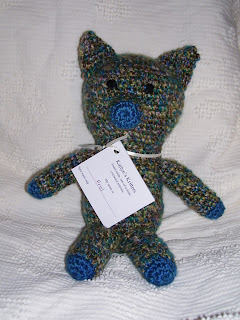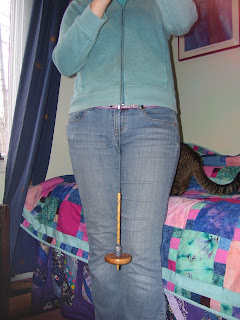Ok. I admit I've not really been into pottery or crochet for a while. I've just been going through the motions for the last week or so because I know I have a show, my first show of the season, on Saturday. I know I needed to be ready for it, but all I've been able to accomplish is the bare minimum to be ready. I priced work, got one last kiln fired, packed up my boxes, and I have everything stacked, ready to go and with my remaining time I've been trying to make a few crocheted animals to take up to Artistree Gallery.
I just don't feel like being a potter. So today I wasn't. Today I was a quilter. And I had a blast. I really did. I got almost an entire quilt top put together in about 5 hours. Plus with the snow coming down outside again, it was nice to be playing with fabric!
 |
| The handkerchiefs my mom found. |
I've seen a couple examples of quick quilts made of handkerchiefs on Pinterest. You can find anything on Pinterest. And it just so happened that my mom found a bag of hankies left over from something my brother did in high school and she asked me if I could do anything with them. Well Yeah! I had actually just seen the examples on Pinterest when she asked me this and I decided today I was going to be a quilter.
I used a white board to work out what I was going to do. I had 6 blue hankies, 4 navy blue, and 5 five red. I was going to cut each one into 4 triangles to make half square triangles. And with my first layout design I needed 17 blue triangles, 16 navy, and 17 red. That would leave me with one whole blue hankie and a partial as well as a partial red hankie. I was hoping I could do a border with what I had left.
My second layout was rectangular and only needed 16 triangles of each color. And I figured that would be 8 half square triangles (HST) of each color combination. This is the layout I planned on using.
I don't like sewing triangles together so I use some shortcuts when I'm making multiples of triangle pieced squares.
And I'll admit right away, I messed up when I started sewing. You see normally when I'm making HST they are small and I make two from each square. You sew diagonally across the square on either side of a draw line and then cut on the line. This time though I needed 4 HST out of each square or hankie. I sewed through the middle of my hankies when I should have sewn around the outside edge and cut on the diagonals to get 4 HST using 1/4 of each hankie. So I'm going to describe what I did instead.
Pair up the hankies based on what color combinations you need in the design. Draw lines diagonally corner to corner both ways.
I sew a presser foot width on either side of the drawn lines. Line up the edge of the presser foot with the drawn line and sew down one side then turn it around and sew down the other side.
Do this on both lines to make a cross of stitches. I chain sewed my hankies, lining up the next seam when I came to the end of the last. You'll waste less thread this way.
 |
| This is where I realized I had done something wrong to make it to my original design. |
Next cut on the drawn lines both directions to make 4 triangles. At this point they are not good for much except maybe a hat or an impromptu bag for berry picking.
 |
| I just made them into smaller HST. |
Then cut vertically from the point to halfway across the bottom.
Do this to all the paired hankies.
Next press all the seams to the dark sides.
I don't know if I've mentioned in other posts that I am a lazy quilter. Unless a square is totally and completely the wrong size, I don't "square up" my squares. I just go with it. I did cut off the little corner bits that stuck out though. This gets rid of some of the extra bulk that occurs anywhere multiple seams meet.
I laid out all the pieces to make sure I liked the way it looked. They could have been rearranged to make diamonds or zigzags, but I like this look, and it didn't require much thinking.
Next sew the individual squares into rows.
And sew the rows into a single top. I still have 2 full blue hankies and a full red one, I'm thinking I may put a border on it yet, but to get to this point only took me about 5 hours. Would have been less if I had realized where I went wrong before I had sewed all the hankies together. I wasn't about to pull out all those stitches, but I improvised a little and ended up with a fun, bright quilt top. Now I just need to put on a border and get batting and a backing fabric. I may have something I can use in my stash right now.
I used the hankies I had on hand, but there are handkerchiefs available in craft stores that are every color of the rainbow and those would make some really fun, bright quilts! And super quick to put together!





























































